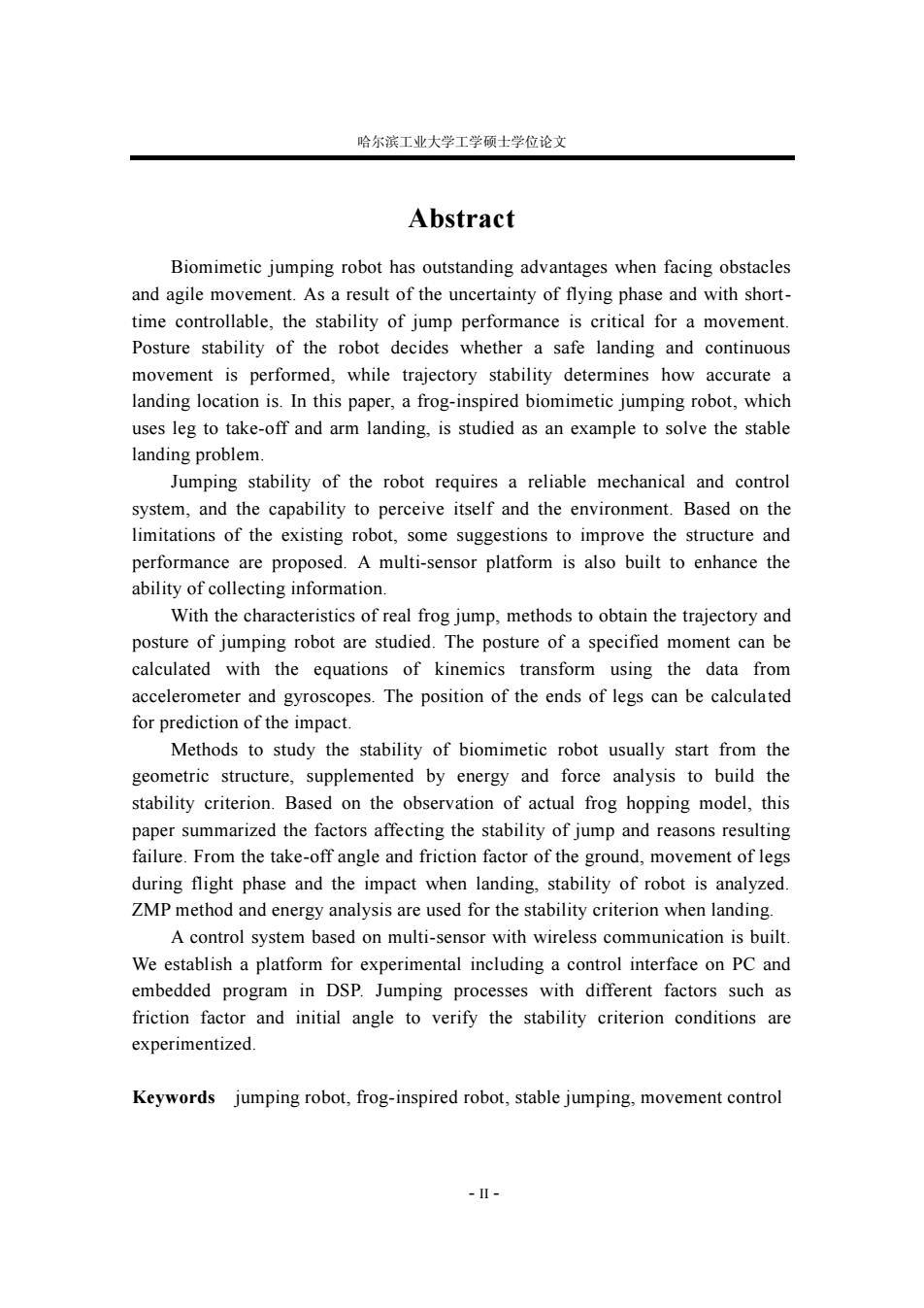正在加载图片...

哈尔滨工业大学工学硕士学位论文 Abstract Biomimetic jumping robot has outstanding advantages when facing obstacles and agile movement.As a result of the uncertainty of flying phase and with short- time controllable,the stability of jump performance is critical for a movement. Posture stability of the robot decides whether a safe landing and continuous movement is performed,while trajectory stability determines how accurate a landing location is.In this paper,a frog-inspired biomimetic jumping robot,which uses leg to take-off and arm landing,is studied as an example to solve the stable landing problem. Jumping stability of the robot requires a reliable mechanical and control system,and the capability to perceive itself and the environment.Based on the limitations of the existing robot,some suggestions to improve the structure and performance are proposed.A multi-sensor platform is also built to enhance the ability of collecting information. With the characteristics of real frog jump,methods to obtain the trajectory and posture of jumping robot are studied.The posture of a specified moment can be calculated with the equations of kinemics transform using the data from accelerometer and gyroscopes.The position of the ends of legs can be calculated for prediction of the impact. Methods to study the stability of biomimetic robot usually start from the geometric structure,supplemented by energy and force analysis to build the stability criterion.Based on the observation of actual frog hopping model,this paper summarized the factors affecting the stability of jump and reasons resulting failure.From the take-off angle and friction factor of the ground,movement of legs during flight phase and the impact when landing,stability of robot is analyzed. ZMP method and energy analysis are used for the stability criterion when landing. A control system based on multi-sensor with wireless communication is built. We establish a platform for experimental including a control interface on PC and embedded program in DSP.Jumping processes with different factors such as friction factor and initial angle to verify the stability criterion conditions are experimentized. Keywords jumping robot,frog-inspired robot,stable jumping,movement control -I-哈尔滨工业大学工学硕士学位论文 - II - Abstract Biomimetic jumping robot has outstanding advantages when facing obstacles and agile movement. As a result of the uncertainty of flying phase and with shorttime controllable, the stability of jump performance is critical for a movement. Posture stability of the robot decides whether a safe landing and continuous movement is performed, while trajectory stability determines how accurate a landing location is. In this paper, a frog-inspired biomimetic jumping robot, which uses leg to take-off and arm landing, is studied as an example to solve the stable landing problem. Jumping stability of the robot requires a reliable mechanical and control system, and the capability to perceive itself and the environment. Based on the limitations of the existing robot, some suggestions to improve the structure and performance are proposed. A multi-sensor platform is also built to enhance the ability of collecting information. With the characteristics of real frog jump, methods to obtain the trajectory and posture of jumping robot are studied. The posture of a specified moment can be calculated with the equations of kinemics transform using the data from accelerometer and gyroscopes. The position of the ends of legs can be calculated for prediction of the impact. Methods to study the stability of biomimetic robot usually start from the geometric structure, supplemented by energy and force analysis to build the stability criterion. Based on the observation of actual frog hopping model, this paper summarized the factors affecting the stability of jump and reasons resulting failure. From the take-off angle and friction factor of the ground, movement of legs during flight phase and the impact when landing, stability of robot is analyzed. ZMP method and energy analysis are used for the stability criterion when landing. A control system based on multi-sensor with wireless communication is built. We establish a platform for experimental including a control interface on PC and embedded program in DSP. Jumping processes with different factors such as friction factor and initial angle to verify the stability criterion conditions are experimentized. Keywords jumping robot, frog-inspired robot, stable jumping, movement control